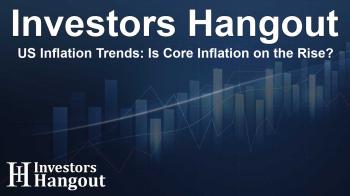US Inflation Trends: Is Core Inflation on the Rise?

Understanding Core Inflation and CPI Dynamics
The landscape of inflation in the US has been quite volatile, signaling various trends that economists and traders watch closely. Recently, there has been a notable trend of ‘disinflation’ or diminishing price pressures. However, predictions indicate a potential shift this month as we anticipate understanding the dynamics of the Consumer Price Index (CPI) report.
Key Insights on US CPI
What to Expect from the CPI Report?
Forecasts suggest that the headline CPI will register around 2.7% year-over-year, while core inflation—which excludes volatile categories such as food and energy—might bounce back to roughly 3.0% year-over-year.
Impact of Price Actions
The US Dollar Index's fluctuations also play a crucial role in this unfolding situation. A surprising inflation result lower than expectations could create conditions for the dollar to decrease further, showcasing the dynamics of economic pressures.
Anticipated Release of the CPI Report
The next release of the CPI report is scheduled for the early hours. While traders eagerly await this information, it could dictate their short-term strategies and responses in the market.
Expectations from the Latest CPI Report
As analysts have underscored, there are significant factors to consider, including the headline CPI projected to hit 2.7% year-over-year. The core inflation reading remains critical amidst discussions around policy adjustments.
Current Inflation Forecasts: What Lies Ahead?
Throughout the year, inflation has gradually veered towards the Federal Reserve's target of 2%. From an initial high of 3.0% year-over-year, the CPI had seen a softening trend, hitting lows of 2.3%. Yet, what complicates matters is the upcoming recalculation of the year-over-year inflation rate, influenced by past readings falling out of the calculations.
Understanding Base Effect Phenomenon
This month, we’re poised to witness the peak impact of the base effect, a situation wherein dropping a lower monthly reading results in an uptick in the annualized inflation rate. Even a zero change month-to-month can push up the annual figure as it replaces an earlier lower reading.
Federal Reserve's Perspective on Inflation
The Federal Reserve is maintaining vigilance over inflation trends, particularly with external pressures such as tariffs affecting the broader economy. It's crucial for policymakers to navigate this landscape wisely, ensuring that they communicate effectively about potential interest rate adjustments without triggering unnecessary market anxiety.
Understanding Market Sentiment
Despite the fluctuations in CPI readings, market sentiments remain cautious. Several traders are factoring in minimal chances of interest rate cuts in the near term, reflecting the overall economic climate’s complexity.
Technical Analysis of the US Dollar Index
As of now, the US Dollar Index (DXY) has been gradually moving higher, testing previous bearish trend levels. It's important for traders to keep an eye on significant resistance and support levels as the market reacts to upcoming inflation data.
Market Movements and Trade Policies
With the current economic environment and anticipated policy decisions on tariffs, developments in international trade may influence market movements more significantly than individual monthly inflation figures. Therefore, ongoing scrutiny of trade negotiations is paramount for understanding future market conditions.
Frequently Asked Questions
What is the significance of the CPI report?
The CPI report provides crucial insights into inflation trends and helps shape economic policy decisions.
How does core inflation differ from headline inflation?
Core inflation excludes food and energy prices, providing a clearer picture of underlying inflation trends.
What impact does inflation have on the economy?
Inflation influences purchasing power, interest rates, and economic growth, affecting consumers and businesses.
Why is the Federal Reserve concerned about inflation?
The Federal Reserve aims to balance inflation with economic growth to maintain stable prices for consumers.
How do tariffs influence inflation?
Tariffs can increase costs for imported goods, contributing to higher consumer prices and inflationary pressures.
About The Author
Contact Lucas Young privately here. Or send an email with ATTN: Lucas Young as the subject to contact@investorshangout.com.
About Investors Hangout
Investors Hangout is a leading online stock forum for financial discussion and learning, offering a wide range of free tools and resources. It draws in traders of all levels, who exchange market knowledge, investigate trading tactics, and keep an eye on industry developments in real time. Featuring financial articles, stock message boards, quotes, charts, company profiles, and live news updates. Through cooperative learning and a wealth of informational resources, it helps users from novices creating their first portfolios to experts honing their techniques. Join Investors Hangout today: https://investorshangout.com/
The content of this article is based on factual, publicly available information and does not represent legal, financial, or investment advice. Investors Hangout does not offer financial advice, and the author is not a licensed financial advisor. Consult a qualified advisor before making any financial or investment decisions based on this article. This article should not be considered advice to purchase, sell, or hold any securities or other investments. If any of the material provided here is inaccurate, please contact us for corrections.

